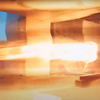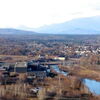Processing Your Payment
Please do not leave this page until complete. This can take a few moments.
Lewiston-Auburn grows as logistics hub | Industrial parks are growing in concert with Lewiston-Auburn's expanding logistics industry. For many Maine distributors, you can get there from here
No ships sail into the second-largest port in Maine and no waves break on these shores.
The Port of Auburn, the name given to a private warehouse and rail terminal off Route 202, handles more tonnage than any of the state’s sea ports, with the exception of Portland. If one did not count the large quantity of oil delivered to Portland, the landlocked Port of Auburn, which handles raw materials for the pulp and paper industry as well as ethanol and other products, would be the state’s most productive port.
The port belongs to Safe Handling of Auburn, a materials distribution company founded in 1989 that receives 5,000 railroad cars a year. The company is one of dozens of businesses located in Lewiston and Auburn that are engaged in the warehousing and distributing of industrial and consumer products.
Partly by design and partly by geography, the twin cities on the Androscoggin have transformed themselves over the last 20 years from fading manufacturers of shoes and textiles into a logistics hub for Maine and New England. The growth of the materials handling business has helped spur a proliferation of industrial parks in the two cities in recent years. Those close to the industry say they believe it will continue to grow, even in the midst of an apparent nationwide recession and challenging times for Maine’s paper mills.
“I’m expecting this is going to be the driver of our economy for an extended period of time,” said Roland Miller, economic development director for the city of Auburn.
The emergence of Lewiston and Auburn as warehouse to the state of Maine begins with the cities’ locations. It was a steep set of falls on the Androscoggin River that attracted those who built the region’s extensive mills in the 19th century, but the more recent wave of development is driven by proximity to the Maine Turnpike, the presence of a key rail line and other transportation amenities.
The St. Lawrence and Atlantic Railroad runs from Auburn to Richmond, Quebec, where it connects with Canadian National Railway, which links Maine with deep water ports in Vancouver to the west and Halifax to the east.
Ford Reiche, president of Safe Handling, said access to the railroad was the major factor in his choosing to locate his business in Auburn 20 years ago. Reiche said he often receives loads of chemicals that are shipped from Asia to Vancouver where they are transferred to rail. On-site customs facilities at the Port of Auburn allow the trains to make a direct run across the continent from the Pacific coast to central Maine.
“Effectively, a lot of what we do is international trade,” Reiche said.
The cities also have the geographical advantage of lying near the center of Maine’s dispersed population. Nearly half of Maine residents live within 30 miles of the twin cities, according to Paul Badeau, marketing director for the Lewiston-Auburn Economic Growth Council.
“If you need to move goods into and out of central and southern Maine, Lewiston-Auburn is a perfect location,” he said.
In recent years, numerous companies have invested in warehousing and distribution facilities to utilize this location. Since 2000, there’s been nearly 1.4 million square feet of this type of development built in Lewiston, according to Lewiston Economic Development Director Lincoln Jeffers. A 21-acre Wal-Mart food distribution center built in 2005 accounts for half this space. The huge retailer’s decision to build in Lewiston played a large part in helping to attract other companies seeking to set up their own distribution centers.
“They really put the community on the national radar screen,” Jeffers said. “Wal-Mart is a market leader and people pay attention to where they go.”
Jeffers credited Wal-Mart’s arrival with helping to fill the city’s newest industrial park. John Gendron completed the Gendron Business Park near Route 196 in 2004. Within two years, Federal Express, a large tire wholesaler and other companies had all set up distribution centers and the park was fully occupied. Gendron is currently seeking permits for a 62-acre expansion.
Beside the appeal of the region’s location and transportation infrastructure, those familiar with the growth of the logistics business in Lewiston and Auburn said city government in both communities has played a significant part in nurturing this industry. Reiche credited city officials with identifying the logistics business as a promising industry decades ago and making far-sighted decisions, such as investing in a rail-to-truck transfer facility, to help encourage its development. He said city officials remain deeply committed to working with local businesses. Last month, for instance, Reiche held a company picnic and among those in attendance were the Auburn mayor, five city councilors, both the city manager and the assistant city manager, and a handful of other municipal officials.
“That’s the level of involvement,” he said.
In Lewiston, Jeffers said the city staff strives to ensure a streamlined set of requirements for developers that makes for a quick and efficient permitting process.
“We make it very clear — here are the rules and here are the standards the project has to meet,” he said. “We pride ourselves on one planning board meeting.”
Shifting in transport
The rapidly growing warehousing and logistics business is driving investments on both sides of the river. The Auburn Business Development Corp. opened the 80-acre Auburn Industrial Park last year and developer Joe Casalinova won approval in June for a 30-acre industrial park in Auburn.
Both parks are designed to meet the needs of those in the business of moving and distributing large quantities of materials. The facilities provide easy access to the Maine Turnpike, the Auburn Lewiston airport and the St. Lawrence and Atlantic Railroad. A nearby intermodal facility, the largest in Maine, allows the quick transfer of shipping containers from rail to truck and vice-versa.
The city of Auburn has taken one more step to promote itself as a logistics hub. The city worked with Maine’s congressional delegation to earn a federal designation as a Foreign Trade Zone in 2004. Companies within the zone can avoid paying duties on imported goods that they unload in Auburn and later ship for resale.
As logical as it may be to envision the continued influx of industrial tenants in Lewiston and Auburn over the long term, there is an element of speculation in the region’s recent business park developments. Casalinova, for instance, said he intends to begin work on his business park this year though he does not yet have a definite commitment from a tenant. The Gendron Park in Lewiston succeeded with this approach, but the Auburn Industrial Park, despite its special trade status, has so far only attracted one tenant. That business, the commodity freight mover Bisson Corp., is not participating in the trade zone.
Badeau, the marketing director for the L-A growth council, said it was common for foreign trade zones to take some time to develop. In Maine, where there are a limited number of companies that engage in international trade, he said it is especially challenging. But Badeau said the city remains hopeful about the trade zone’s potential.
Poised for production
Casalinova said he also remains confident that he can fill his new industrial park. With the dramatic rise in fuel costs, he said companies are increasingly looking for access to rail as a way to lower shipping costs. Those savings are attractive to manufacturers as well as distributors. With its visibility from the Maine Turnpike, Casalinova said he believes his park will fill a different niche than the Auburn Industrial Park. He said he believes his facility will be attractive to companies seeking to produce and distribute from the same location, and several food service companies have already contacted him with plans of this sort.
Though he does not have a firm agreement with any of these companies, Casalinova said he has received a letter of intent. He said he could not expect more of a commitment until he had built the park.
“In this day and climate, you have to have a product ready to go,” he said.
Despite the ailing national economy, Badeau said he believes local developers are investing wisely by betting on continued growth in demand for industrial space in Lewiston and Auburn. Badeau said the same reasons that companies have set up logistics operations in Lewiston and Auburn over the last decade — access to transportation, affordable land and proximity to markets — will continue to draw new businesses.
In fact, he said, an economic downturn could provide an opportunity for developers to position themselves ahead of this demand. “One could argue that that this is the exactly the time you would want to be planning an industrial park so when the economy does turn around, this community stands to benefit.”
Though his outlook is decidedly optimistic over the long term, Badeau said he recognizes there is real uncertainty in the short term.
“I can’t tell you this space will be filled in 12 or 14 months,” he said. “The return on investment will definitely come.”
Racking up the miles
Whether the growth of the logistics business can match developers’ enthusiasm for building new parks, the industry has provided steady growth for the region’s railroad and airport.
Since 1995, the St. Lawrence and Atlantic railroad has added about 17 new customers, largely because of the number of logistics and warehousing businesses clustering in the Lewiston-Auburn region, said Ed Foley, the railroad’s marketing director.
Because the St. Lawrence and Atlantic is a subsidiary of a larger company, Foley said he could not discuss the railroad’s financial specifics. He did say that the growth in Lewiston and Auburn was helping to offset a sharp downturn in the paper industry that had been marked by the disappearance of three paper mills that had relied on the 270-mile St. Lawrence and Atlantic over the last four years.
Sixty percent of the railroad’s business is still connected to the paper industry, hauling pulp, fiber and chemicals to the mills and carrying rolls of finished paper in the other direction. In the last few years, Foley said the railroad experienced steady growth in hauling other sorts of consumer goods as companies seek to take advantage of the efficiencies of rail. With convenient facilities for transferring from rail to truck, Auburn’s transportation infrastructure is well suited for this new line of business.
“In this day and age it’s all about carbon footprint reduction,” he said. “We’re looking at maximizing the ability for rail to do longer distances and to do local delivery by truck.”
Business has also been brisk at the Auburn-Lewiston Municipal Airport. In the last two years, the third-busiest airport in the state has seen growth of between five and eight percent a year, according to airport manager Rick Cloutier.
Cloutier said it’s difficult to pinpoint exactly how much of the growth is related to the logistics business but the number of corporate jets is noticeably higher, and the spurt has coincided with much of the growth in this industry In previous years, he said the airport typically grew at a rate of one or two percent.
Nor has the downturn in the economy grounded many flights at the airport. This year, Cloutier said the takeoffs and landings are on track to grow five percent over last year and the airport will likely record its busiest year ever.
“We’re right on pace,” he said.
Seth Harkness, a writer in Portland, can be reached at editorial@mainebiz.biz.










Comments